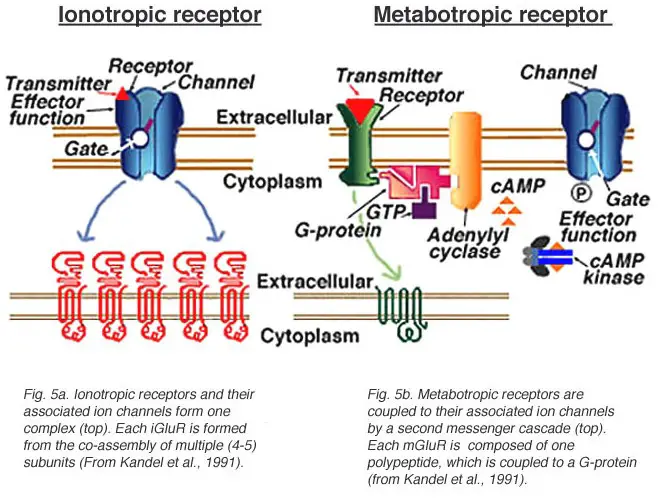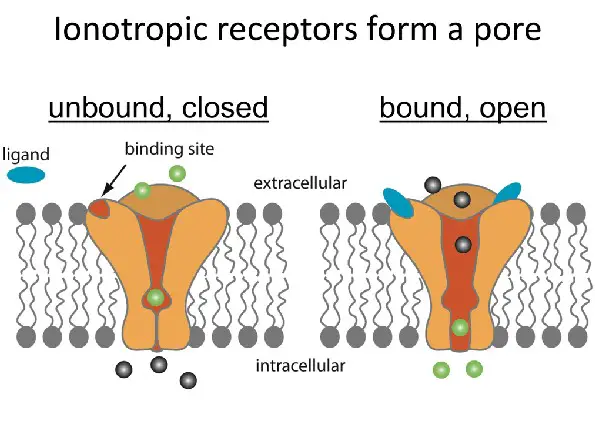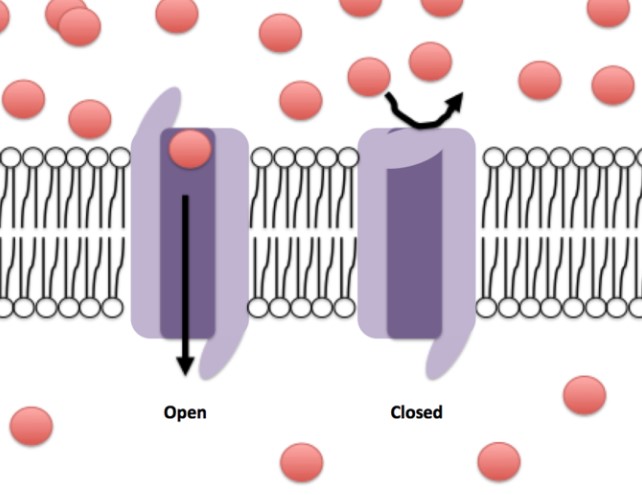Neurotransmission, the process by which signals are transmitted between neurons, is foundational to understanding how the brain functions. At the heart of this complex system are receptors, which are proteins that receive and translate these signals into cellular responses. These receptors are not all created equal, and their differences have profound implications for how signals are processed in the brain.
Ionotropic and metabotropic receptors are the two primary types of receptors involved in neurotransmission. Ionotropic receptors are known for their rapid response, acting as gatekeepers for ions to flow through the cell membrane. Metabotropic receptors, on the other hand, initiate a series of reactions within the cell that can have longer-lasting effects. Both play critical roles in the functioning of the nervous system, but their mechanisms of action and the outcomes of their activation are distinct.
Understanding these differences is crucial for grasping the broader picture of neural communication and its impact on behavior, cognition, and disease. By examining the structure, mechanism, and functional significance of ionotropic and metabotropic receptors, we gain insights into the intricate ballet of brain activity and how it underpins every aspect of human experience.

Receptor Basics
Definition and Function
Receptors are proteins located on the cell surface or within cells. They bind to specific molecules, such as hormones, neurotransmitters, or drugs, and initiate a cellular response. This interaction is pivotal for transferring signals across the cell membrane and into the cell, affecting cellular activity and function.
Role in Signal Transduction
Signal transduction is the process by which a chemical or physical signal is transmitted through a cell as a series of molecular events, most commonly protein phosphorylation catalyzed by protein kinases, which ultimately results in a cellular response. Receptors are critical in this process, acting as the initial contact point for signals. They convert external signals into internal messages, a role essential for maintaining cellular homeostasis and responding to the environment.
Ionotropic Receptors
Structure
Ionotropic receptors are multimeric proteins that span the cell membrane. They consist of several subunits that form a central pore. When a neurotransmitter binds to the receptor, it causes a conformational change that opens the pore, allowing ions to pass through.
Composition and Architecture
These receptors are composed of four to five subunits that can be the same (homomeric) or different (heteromeric), contributing to the receptor’s diversity and specificity. The arrangement of these subunits around a central ion channel is critical for the receptor’s function and its selectivity for specific ions, such as sodium, potassium, calcium, or chloride.
Mechanism
Activation and Ion Channel Operation
Upon binding of the neurotransmitter to the receptor, the channel undergoes a conformational change that opens the ion channel. This allows ions to flow across the membrane, following their electrochemical gradient. The movement of ions changes the membrane potential, leading to cellular responses such as neural excitation or inhibition.
Key Features
Speed of Response
Ionotropic receptors are known for their fast response times, often in the range of milliseconds. This speed is crucial for rapid synaptic transmission, allowing for quick communication between neurons.
Examples in the Nervous System
- NMDA receptors: Involved in synaptic plasticity and memory formation.
- GABA<sub>A</sub> receptors: Mediate inhibitory neurotransmission, crucial for preventing over-excitation.
Metabotropic Receptors
Structure
Metabotropic receptors, also known as G-protein-coupled receptors (GPCRs), are a large family of receptors that operate through indirect mechanisms. Unlike ionotropic receptors, they do not form ion channels but instead activate G proteins.
G-Protein-Coupled Receptors (GPCRs)
GPCRs are characterized by their seven transmembrane helices. The activation of these receptors by ligands leads to the activation of G proteins, which then interact with other cellular effectors such as enzymes or ion channels, initiating a cascade of intracellular events.
Mechanism
Activation and Signal Cascade Initiation
When a ligand binds to a metabotropic receptor, it activates an associated G protein, which then dissociates into subunits. These subunits interact with other proteins, starting a signaling cascade that can amplify the signal and lead to various cellular responses, including changes in gene expression, enzyme activity, or ion channel function.
Key Features
Duration of Effects
The effects of metabotropic receptor activation are typically slower to develop but can be more prolonged and diverse than those mediated by ionotropic receptors. This is due to the amplification of the signal through the cascade of intracellular events they initiate.
Examples and Their Functions
- Muscarinic acetylcholine receptors: Involved in modulating the central nervous system and peripheral organs.
- Dopamine receptors: Play roles in mood regulation, reward, and motor control.

Comparative Analysis
Activation Speed
Ionotropic vs. Metabotropic
The primary difference between ionotropic and metabotropic receptors lies in their activation speed. Ionotropic receptors provide rapid responses, acting within milliseconds of neurotransmitter binding. This is because their response involves the direct opening of an ion channel, allowing ions to flow across the cell membrane immediately.
In contrast, metabotropic receptors initiate a series of intracellular events that take longer to unfold. The activation of a G protein, followed by a signaling cascade, means that the effects can take seconds to minutes to manifest. This slower response is due to the indirect nature of their action, which does not involve the immediate opening of ion channels but rather influences cellular processes through secondary messengers.
Signal Amplification
Single vs. Multiple Steps
Another key difference is signal amplification. Ionotropic receptors’ effects are generally localized and limited to the vicinity of the receptor because they involve a single step of opening an ion channel. There is no amplification of the signal within the cell, leading to a one-to-one relationship between neurotransmitter binding and ion channel opening.
Metabotropic receptors, however, can amplify signals through multiple steps in their signaling cascades. A single ligand-receptor interaction can activate several G proteins, each of which can then regulate the activity of various downstream effectors. This amplification allows a small number of ligand molecules to have a large effect on the cell.
Functional Impact
Immediate vs. Long-term Effects
The functional impact of ionotropic and metabotropic receptor activation also varies. Ionotropic receptors mediate immediate effects that are crucial for fast synaptic transmission, allowing neurons to communicate quickly. This rapid action is essential for functions requiring instantaneous responses, like reflexes and fast-paced signaling in the central nervous system.
Metabotropic receptors, due to their ability to initiate widespread intracellular changes, can have long-term effects on cells. They are involved in processes that require gradual modulation, such as learning, memory, and the regulation of neuronal excitability over time. These receptors can alter gene expression and protein synthesis, leading to lasting changes in cell function.
Biological Significance
Ionotropic in Fast Synaptic Transmission
The fast synaptic transmission mediated by ionotropic receptors is vital for the neurological processes that require immediate action. For example, the acetylcholine receptor at neuromuscular junctions enables the quick initiation of muscle contraction following a motor neuron’s firing. Similarly, GABA<sub>A</sub> receptors in the brain rapidly inhibit neuronal activity, preventing over-excitation that could lead to seizures.
Metabotropic in Modulatory Roles
Metabotropic receptors play key modulatory roles in the nervous system, affecting neuronal excitability and synaptic plasticity over longer periods. For instance, metabotropic glutamate receptors (mGluRs) are involved in neuronal development, neuroprotection, and memory formation. By modulating the strength of synaptic connections, these receptors contribute to the brain’s ability to adapt and learn.
Therapeutic Implications
Targeting Ionotropic Receptors
Drug Development and Challenges
The direct and rapid action of ionotropic receptors makes them attractive targets for therapeutic intervention. Drugs that act on these receptors can have immediate effects, which is crucial for conditions requiring rapid relief, such as pain, anxiety, and epileptic seizures. However, designing drugs that selectively target specific ionotropic receptors without causing side effects is challenging due to the similarity of these receptors across different neurotransmitter systems.
Targeting Metabotropic Receptors
Potential Therapeutic Areas
Metabotropic receptors offer potential therapeutic targets for a broad range of conditions, given their role in modulating long-term cellular processes. By targeting these receptors, drugs can potentially influence processes like mood regulation, cognitive function, and chronic pain management. The challenge lies in achieving the right balance of efficacy and specificity, as the widespread effects of metabotropic receptors can lead to unintended consequences in other parts of the nervous system.

Frequently Asked Questions
What are Ionotropic Receptors?
Ionotropic receptors are proteins that form ion channels across the neuron’s membrane, opening in response to a neurotransmitter. This action allows ions like sodium or calcium to rush in or out, initiating a rapid response such as muscle contraction or a change in neural firing. Their swift action is essential for fast synaptic transmission in the nervous system.
How Do Metabotropic Receptors Work?
Unlike ionotropic receptors, metabotropic receptors do not form ion channels. Instead, they activate G proteins and initiate a signaling cascade within the cell. This process can modulate the activity of various enzymes, ion channels, and other cellular processes, resulting in a slower, but often more sustained, response.
Why are Receptor Types Important in Neuroscience?
The distinction between ionotropic and metabotropic receptors is crucial in neuroscience because it helps explain the diversity of responses to neurotransmitters in the nervous system. Understanding these differences is key to deciphering how the brain processes information, responds to the environment, and how different drugs can affect brain function and behavior.
What are the Therapeutic Implications of These Receptors?
Both ionotropic and metabotropic receptors are targets for drugs to treat a variety of neurological and psychiatric conditions. By modulating the activity of these receptors, medications can enhance or inhibit specific neurotransmitter systems, offering potential treatments for issues like anxiety, depression, epilepsy, and schizophrenia.
Conclusion
The exploration of ionotropic and metabotropic receptors uncovers the depth of complexity in neural communication and its profound implications for understanding the human brain. Through their distinct mechanisms, these receptors orchestrate a wide range of physiological and psychological phenomena, from the snap of a quick reflex to the gradual modulation of mood.
As we advance our knowledge of these critical components of the nervous system, we open new avenues for treating neurological disorders and enhancing brain health. The differences between ionotropic and metabotropic receptors not only enrich our understanding of the brain’s inner workings but also highlight the nuanced approaches needed to harness this knowledge for therapeutic ends.

